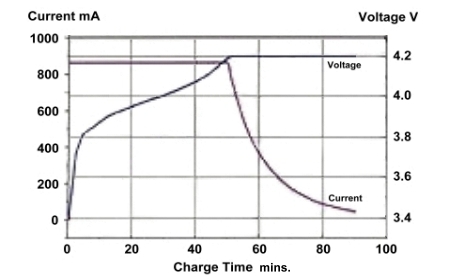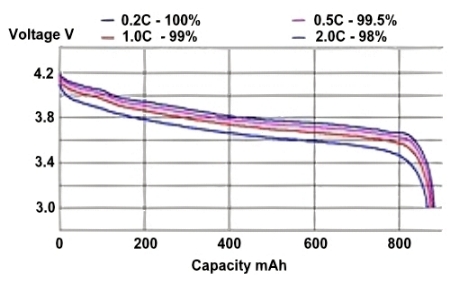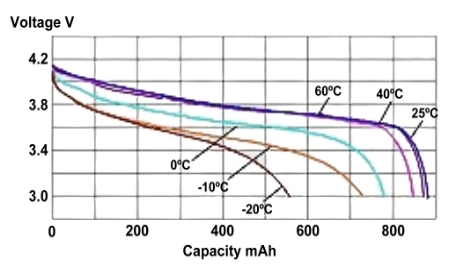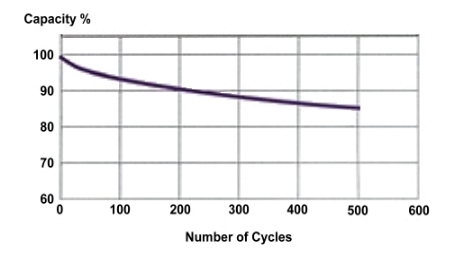| |
|
|
|
Lithium Polymer (Li Po) Cells and Battery packs
|
|
|
|
|
|
|
TYPICAL LITHIUM ION POLYMER TECHNICAL DATA
|
The Lithium Polymer (Li Po) Cell range includes 200 models which offer designers increased flexibility when it comes to developing next generation portable devices. The cells come in low profile, high energy density packages for fitting into those tightest of spaces. With this technology advance, cells have been made lighter providing reduction in the overall end product weight. For an overall product solution cells or battery packs can be factory assembled with protection circuit modules (PCM).
| Lithium Polymer Cell Specification |
| Nominal Voltage |
3.7V |
| Nominal Capacity |
100mAh to 4500mAh‡ |
| Charge |
Method |
Constant Current (CC) / Constant Voltage (CV) |
|
Max. Current
|
1C
|
| Max. Voltage |
4.2V† |
| Discharge |
Max. Current |
1C (higher rate cells available) |
| Termination |
3.0V† |
| Operating Temperate |
Charge |
0ºC to +45ºC |
|
Discharge
|
-20ºC to +60ºC
|
| Storage |
1 month |
-20ºC to +35ºC |
|
4 months
|
-20ºC to +25ºC
|
| Life Expectancy |
Minimum ¥ |
>300 cycles (80% rated capacity) |
| Typical |
500 cycles (see graph below) |
| Notes: |
| † Charge termination and discharge termination required. |
| ‡ CC/CV charge 4.2V, 1C until current drops below 0.01C , rest for 1-2 hrs then CC discharge 0.2C to 3.0V (temperature 20±5ºC), may require up to 5 cycles. |
| ¥ CC/CV charge 4.2V, 1C until current drops below 0.01C , rest for 10 min. then CC discharge 1C to 3.0V, rest for 10 min and repeat cycle (temperature 20±5ºC). |
|
Typical Charge Graph (Cell Capacity: 850mAh)
|
|
CC/CV Charge at 4.2V, 1C +25ºC
|
 |
|
Typical Discharge Graph
|
|
CC/CV Charge at 4.2V, 0.5C, +25ºC. CC Discharge to 3.0V, +25ºC.
|
 |
|
Typical Discharge Graph
|
|
CC/CV Charge at 4.2V, 0.5C, +25ºC. CC Discharge at 0.5C to 3.0V.
|
 |
|
Typical Cycle Graph
|
|
CC/CV Charge at 4.2V,1C, +25ºC. CC Discharge at 1C to 3.0V, +25ºC.
|
 |
Lithium Polymer Cells and Battery Packs
|
|
| IBT can offer Lithium Polymer (Li Po) cells with protection circuit modules (PCM) factory fitted to the cell. The pcb's provide protection against over voltage, under voltage and over current / short circuits. Even with this pcb fitted discharge termination and charge termination are required. The PCM will increase the dimensions of the bare cell dimensions, as a guide it will add up to 2 mm to the length of the cell, please contact IBT for further details. Flying leads and output connectors can be fitted as required. |
|
| Where more power is required cells can be factory assembled to form high energy density light weight battery packs, incorporating battery PCM. Cells can be arrange in series or in parallel providing a flexible solution to maximise battery compartment space. As with the cell packs flying leads and output connectors can be fitted as required. For higher volume packs plastic cased product can be developed from a 3D drawings, some standard plastic cased product is available. please contact IBT for further details. |
|
| Battery Chargers & Charging |
|
| A number of options exist for charging lithium polymer battery packs and cells; for designers wishing to build there own charge circuits there are a number of charging chips on the market, which provide options to charge via a dc power source or USB port. It is important to choose an IC with a charge termination facility, some terminate charge via monitoring the end of charge current and some use temperature sensing normally using a 10kΩ NTC termistor fixed to the cell or battery, others use a combination of the two. For the current sensing method it is recommended to terminate the charge once the current drops below 0.02C to 0.01C. Another alternative is an intelligent exteral battery charger in either a plug in the wall or desk top format. The charge circuit is in built so that it does not take up valuable space in a portable device. |
|
| Precautions
To prevent a possibility of the battery from leaking, heating or explosion please observe the following precautions:
|
|
Warning ! |
 |
Do not immerse the battery in water or other liquid. |
 |
Do not use or leave the battery near a heat source such as fire or heater.
|
 |
Do not use the battery to power any other device.
|
 |
When recharging, only use specified battery charger.
|
 |
Do not reverse the positive (+) and negative (-) terminals.
|
 |
Do not connect the battery to an electrical outlet.
|
 |
Do not discard the battery in fire or expose it to a flame.
|
 |
Do not short-circuit the battery by directly connecting the positive (+) and negative (-) terminal with metal objects. |
 |
Do not transport or store the battery together with metal objects.
|
 |
Do not strike, throw, drop or damage the battery
|
 |
Do not try to pierce, disassemble or modify the battery.
|
 |
Do not use the battery in a corrosive environment. |
 |
Do not directly solder to the battery.
|
 |
Do not put the battery into a microwave oven
|
|
|
|
|
Caution ! |
 |
Always read the manufacturers manual for the device before operating, trying to charge, install or remove the battery.
|
 |
Store batteries out of reach of children.
|
 |
Do not use or leave the battery at very high temperature (for example, at strong direct sunlight or in a vehicle in extremely hot weather). Otherwise, it can overheat, catch fire or its performance will be degenerate and its service life will be decreased.
|
 |
Do not use it in a location where static electricity is great, otherwise, the safety devices may be damaged, causing hidden trouble of safety.
|
 |
If the battery leaks, and the electrolyte get into the eyes. Do not rub eyes, instead, rinse the eyes with clean running water, and immediately seek medical attention. Otherwise, it may injure eyes or cause a loss of sight.
|
 |
If the battery does not charge properly or it is not lasting very long, stop using it and replace it with a new one.
|
 |
If the battery gives off an odor, generates heat, becomes discolored or deformed, or in any way appear abnormal during use, recharging or storage, immediately remove it from the device or battery charger and stop using it.
|
 |
In case the battery terminals are dirt, clean the terminals with a dry cloth before use. Otherwise power failure or charge failure may occur due to the poor connection with the instrument.
|
 |
Be aware discarded batteries may cause fire, tape the battery terminals to insulate them. Recycle batteries where possible and abide by local disposal guidelines and directives. |
 |
Do not leave the battery in a discharged state, always recharge it after use, otherwise it could lead to loss of performace or in more sereve causes make the battery useless.
|
 |
If the battery is not in use for an extended period of time remove it from the device and store it in a cool, dry, clean environment. When storing for extended periods charge the battery to 50% and recharge it at the intervals stated above under Storage.
|
|
|
|

